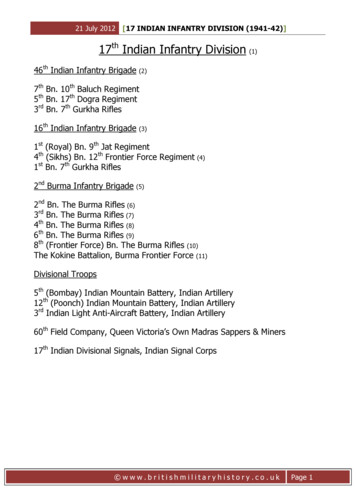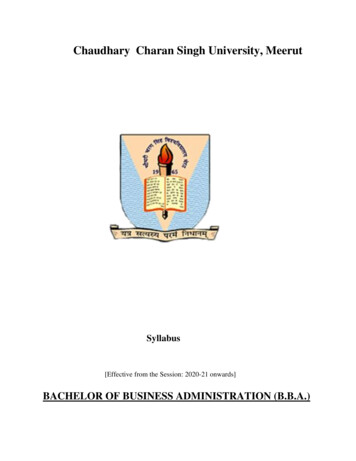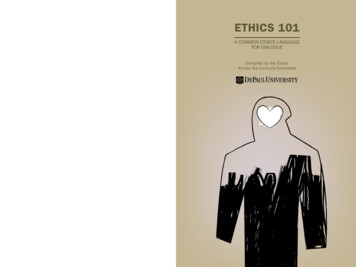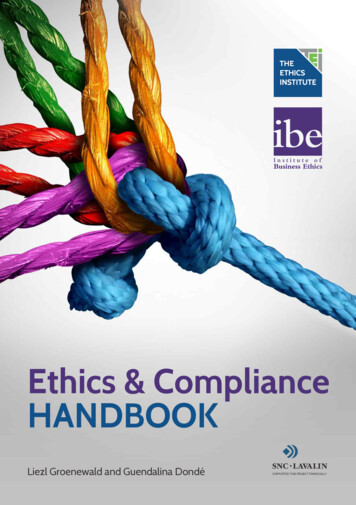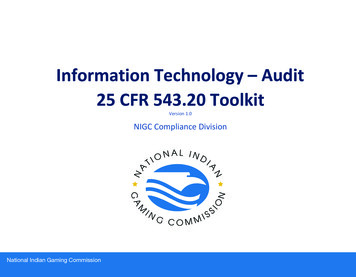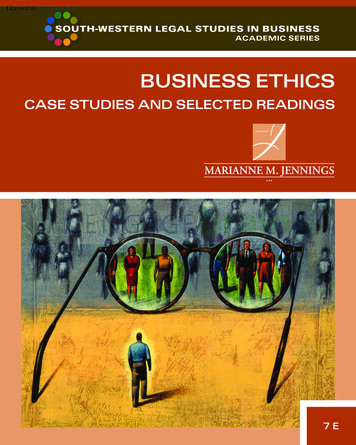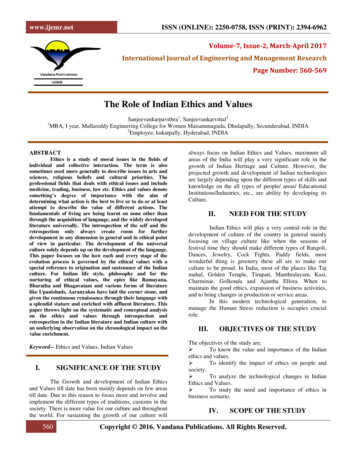
Transcription
www.ijemr.netISSN (ONLINE): 2250-0758, ISSN (PRINT): 2394-6962Volume-7, Issue-2, March-April 2017International Journal of Engineering and Management ResearchPage Number: 560-569The Role of Indian Ethics and Values1Sanjeevankarpavithra1, Sanjeevankarvittal2MBA, I year, Mallareddy Engineering College for Women Maisammaguda, Dhulapally, Secunderabad, INDIA2Employee, kukatpally, Hyderabad, INDIAABSTRACTEthics is a study of moral issues in the fields ofindividual and collective interaction. The term is alsosometimes used more generally to describe issues in arts andsciences, religious beliefs and cultural priorities. Theprofessional fields that deals with ethical issues and includemedicine, trading, business, law etc. Ethics and values denotesomething’s degree of importance with the aim ofdetermining what action is the best to live or to do or at leastattempt to describe the value of different actions. Thefundamentals of living are being learnt on none other thanthrough the acquisition of language, and the widely developedliterature universally. The introspection of the self and theretrospection only always create room for furtherdevelopment in any dimension in general and in ethical pointof view in particular. The development of the universalculture solely depends up on the development of the language.This paper focuses on the how each and every stage of theevolution process is governed by the ethical values with aspecial reference to origination and sustenance of the Indianculture. For Indian life style, philosophy and for thenurturing of ethical values, the epics like Ramayana,Bharatha and Bhagavatam and various forms of literaturelike Upanishads, Aaranyakas have laid the corner stone, andgiven the continuous renaissance through their language witha splendid stature and enriched with affluent literature. Thispaper throws light on the systematic and conceptual analysison the ethics and values through introspection andretrospection in the Indian literature and Indian culture withan underlying observation on the chronological impact on thevalue enrichment.Keyword-- Ethics and Values, Indian ValuesI.SIGNIFICANCE OF THE STUDYThe Growth and development of Indian Ethicsand Values till date has been mainly depends on few areastill date. Due to this reason to focus more and involve andimplement the different types of traditions, customs in thesociety. There is more value for our culture and throughoutthe world. For sustaining the growth of our culture will560always focus on Indian Ethics and Values, maximum allareas of the India will play a very significant role in thegrowth of Indian Heritage and Culture. However, theprojected growth and development of Indian technologiesare largely depending upon the different types of skills andknowledge on the all types of people/ areas/ EducationalInstitutions/Industries, etc., are ability by developing itsCulture.II.NEED FOR THE STUDYIndian Ethics will play a very central role in thedevelopment of culture of the country in general mainlyfocusing on village culture like when the seasons offestival time they should make different types of Rangoli,Dances, Jewelry, Cock Fights, Paddy fields, mostwonderful thing is greenery these all are to make ourculture to be proud. In India, most of the places like Tajmahal, Golden Temple, Tirupati, Manthralayam, Kasi,Charminar, Golkonda and Ajantha Ellora. When tomaintain the good ethics, expansion of business activities,and to bring changes in production or service areas.In this modern technological generation, tomanage the Human Stress reduction is occupies crucialrole.III.OBJECTIVES OF THE STUDYThe objectives of the study are: To know the value and importance of the Indianethics and values. To identify the impact of ethics on people andsociety. To analyze the technological changes in IndianEthics and Values. To study the need and importance of ethics inbusiness scenario.IV.SCOPE OF THE STUDYCopyright 2016. Vandana Publications. All Rights Reserved.
www.ijemr.netISSN (ONLINE): 2250-0758, ISSN (PRINT): 2394-6962The study is majority covering the all IndianEthics and that related aspects from different people andtheir views about Indian Habits, importance of traditionand different models and styles of dresses and dances.Basically, the data what I required to study for this projectmaximum availability and supports from villages onlyThe above concepts covered with a sample ofdifferent people from the villages, educational institutions,rural areas like out cuts of Hyderabad comprising a totalsample of 130 different cultural people.V.METHODOLOGYResearch DesignA research designs is a specific action of themethod and procedures for acquiring the informationneeded to structure or solve the problems. It is an overalloperational framework project has stipulated whatprocedures. The research design ensures that theinformation obtained is relevant to the study. A researchdesign might be described as a series of advances.Decisions that have taken together from a special masterplan or a model for the conduct of investigations. Theseare different types of research designs used to applied fordifferent or suitable conditions for this research.The primary and secondary data have beencollected for the study. The primary data have beencollected by conducting interviews and discussions, withpeople in villages and those who are running the differentNGO‟s and Trusts like old age homes, Orphanages,educational institutions, speakers form different types ofreligious, pandits from different temples supplying twotypes of structured questionnaires‟ schedule. Theinformation has also been collected through the interviewsand personal observations so as to derive the effectivenesson the study and to draw the meaningful conclusions.The secondary sources of data have beencollected from the Institutions, Records, Reports,Published Books, Unpublished Research Reports, Journals,Magazines, News Papers, Web Sites, etc.Opinions of the respondents have been solicitedon five-point scale with scale values 5,4,3,2 and 1,opinions which fall under scale 3 are not considered as therespondents want to be silent on those issues forpresentation and calculation purposes.Various statistical tools are used. Frequency test,Cross tabulation, Factor Analysis, Scale Reliability, and aresearcher used for Correlation and Regression. To find thevarious Cultures internally to know the various functionsin Indian Culture. Correlation coefficient is using to checkthe consistency of the data, the total data and calculatedvalue for the most of the tables as the opinions are varyingfrom one area to another area and also to observe theopinions of the all respondents.VI.561SAMPLINGData for this study have been collected based onthe stratified convenient sampling‟ technique.VII.STATISTICAL TOOLS USED INTHE STUDYTo analyze the data the following statistical toolsare used.The percentages, weighted averages, are usedwherever necessary: mean, coefficient of variance andstandard deviation are used according to the necessity andthe compatibility. The Statistical data have been shown inthe form of Tables, Bar Diagrams, Pie Diagrams, etc. TheScaling techniques have been used to analyze opinions of adifferent types of saints from various places and studentsand faculty from institutions as well as public. TheCorrelation and the Regressions have also been calculatedfor the variables.VIII. LIMITATIONS1. Time constraint is also there in the study in covering thevarious locations of surrounding places in Hyderabad.2. The financial constraint is also there in the study as theexpenditure on study is completely born by the researcher.3. It is due to the confidentiality, the Institutions coveredunder the study are unable to give the confidentialinformation.4. The time spent by the respondents is very less, whileinteracting with the researcher.Introduction:IX.REVIEW OF LITERATUREIndian culture plays an important role ininculcating ethical values. Indian values gave primeimportance to right to happiness for all human beings.Indian culture is complex in nature and with diversity inreligion and their customs we live with unity. The twomost important tenets of Indian culture are human Valuesand Holism. Human values refer to moral, spiritual andethical values while Holism means oneness or unity.Indian culture is very rich and diverse and teaches us to betolerant to others. Human values are inculcated from theVedic teachings to lead a peaceful integrated life. IndianCulture shows us evidences of development of values inlife by training and experience. The Bhagawad Gita isconsidered as the essence of the Vedas and Upanishads.Important values that are ever relevant and unchanging arefound in the form of scriptural texts in the Indian culture.1. Vedas2. Bhagavad Gita3. Manusmriti4. Ramayana5. Kama sutraCopyright 2016. Vandana Publications. All Rights Reserved.
www.ijemr.netISSN (ONLINE): 2250-0758, ISSN (PRINT): 2394-69626. Jataka-tales7. DhammapaddaVedas:The Vedas teaches how to perform them. Itcontains entire range of knowledge. Veda is the source ofall Dharma i.e. religion, morality, righteousness and goodconduct. It has the highest authority over other materials ofthe past. According to the Vedas, the nobler virtue is truth,and then follows other virtues.Vedas are the oldest sacred books of Hinduism.Indian literature begins with the Vedas. They wereprobably composed beginning about 1400 B.C. The Vedaswere a series of sacred texts used in religious rituals andsacrifices and composed in an early form of Sanskrit(Vedic Sanskrit). Even in modern times, the Vedas areregarded as the cornerstone of Hinduism. The Vedasinclude the basis of the doctrines concerning Hindudivinities. They also present philosophical ideas about thenature of Brahman, Hinduism's supreme divine being. Theword Veda comes from the root 'Vid' which meansknowledge.There are four Vedas. The oldest Vedic texts arethose of the Rig Veda, dating from about the 1300's B.C.These are mostly mythical poems to the great Vedic gods-Indra the Warrior, Agni the god of fire, Surya the sun god,and Varuna the upholder of heaven and earth. The laterbooks of the Vedas are the Yajur Veda (mainly formulasfor sacrifice), Sama Veda (poetry from the Rig Vedaadapted to melodies as priestly chants), and Atharva Veda(verses dealing with peace and prosperity and the daily lifeof human society). The Vedas are also called Samhitas.Hindu law permitted only certain people to hear the Vedasrecited, and so the works became surrounded by mystery.Nevertheless, ideas presented in the Vedas spreadthroughout Indian culture.Rig Veda:Being the oldest of the Vedic literature, it is mostimportant because it is the valuable record of ancient India.It has ten books or mandalas containing 1028 hymns bythe successive generations of Rishis (sages). As the Aryanshad no script of their own, the hymns of the Rig Veda werememorized and passed on orally from one generation tothe other before being recorded in written form at a muchlater stage. It has many mantras like the Gayathri mantraswhich are resided by the Hindus in their houses. It is saidto represent the voice of Gods. Many hymns were writtenin the praise of different Gods of nature. The Rig-Vedagives us information not only on the early Vedic religionand their Gods but also on the social condition of thosedays. It points to settled people, and organized society andfull grown civilization.Sama Veda:It mainly contains verses taken from Rig-Vedawith reference to Soma sacrifices. Its hymns are set tomusic. The Sama Veda has hymns meant for the priest562only who sang them at the time of the performance ofYajnas. It tells us much about the music of ancient Aryans.Yajur Veda:It contains hymns concerning sacrifices. Thestudy of this Veda shows that the Aryans had acquiredknowledge of sacrifices by that time. It depicts changes insocial and religious conditions which had come in thesociety from the period of Rig-Veda. The Yajur Veda hastwo parts - the white and the black. The former consists ofhymns and latter contains commentaries.Atharva Veda:It contains mantras on three topics - Gnana(Knowledge), Karma (deeds), and Upanishad (invocation).It is important from the point of view of knowing thehistory of science in India. It is also collection of spellsand charms which are popular among the people. ThisVeda throws light on the beliefs of the people some of theMantras are meant to bring success in life, while somewhere used to ward off evil spirits responsible for diseaseand sufferings. This Veda believed to be a latercomposition and contains some non-Aryan material. Itseems to have been composed when a synthesis of Aryanand non-Aryan cultures took place.Bhagavad Gita:The Bhagavad Gita acts as powerful catalyst forchange and renovation in one‟s life. The verses from thisbook contribute to improve self-reflection, better thesenses and expands one‟s inner development, makes thelife more active and joy at any circumstances, throughattitudinal changes in the individuals. It offers us the toolsto connect with our deepest insubstantial spirit, and leadsus to participate in the battle of life.The Bhagavad-Gita isuniversally renowned as the jewel of India's spiritualwisdom. Spoken by Lord Krishna, the SupremePersonality of Godhead to His intimate disciple Arjuna, theGita's seven hundred concise verses provide a definitiveguide to the science of self-realization. No otherphilosophical or religious work reveals, in such a lucid andprofound way, the nature of consciousness, the self, theuniverse and the Supreme.His Divine Grace A.C. Bhakti Vedanta SwamiPrabhupada is uniquely qualified to present this Englishtranslation and commentary on Bhagavad-Gita. He is theworld's foremost Vedic scholar and teacher, and he is alsothe current representative of an unbroken chain of fullyself-realized spiritual master‟sbeginning with Lord KrishnaHimself. Thus, unlike other editions of the Gita, this one ispresented as it is--without the slightest taint of adulterationor personal motivation.Manusmriti:Manusmriti is one of the earliest and mostauthoritative law texts followed by the Hindus, covering awide range of topics such as creation of the world,sacraments like „Upanayana‟ and marriage; duties of menand women placed in different strata of society and stagesof life; penitential rites for violation of codes of conduct;Copyright 2016. Vandana Publications. All Rights Reserved.
www.ijemr.netISSN (ONLINE): 2250-0758, ISSN (PRINT): 2394-6962and so on. According to Manusmriti, Dharma is essentialfor the individual‟s happiness and for the family and thesociety.Manusmriti, translated "Laws of Manu" or"Institutions of Manu," is the most important andauthoritative Hindu Law Book (Dharmashastra), whichserved as a foundational work on Hindu law andjurisprudence in the ancient Indian society. Until themodern times it was the standard reference for both therulers who patronized Vedic faith and the people whopracticed it.Manu in Hindu tradition is considered to be thefirst of Brahma's sons and a progenitor of human race.Therefore, it is difficult to determine the age ofManusmriti. The laws of Manu might have been known tothe Vedic people for a long time before they were codifiedinto their present form sometime during the post Vedicperiod. The work that we have today as Manusmriti mighthave reached its final form through the contribution ofmany by 200 CE.Ramayana:Ramayana contains the universal human valuesand the sense of morality which can regulate the code ofsociety for the betterment of establishing peace. It isbecause, through various characters, social and moralvalues are displayed. There is an explanation in this epic todifferentiate the term human value from social value.Rama sacrificed all his pleasures for the welfare of thesubjects of his kingdom. Dasharatha was the King ofAyodhya and had three wives and four sons. Rama was theeldest and his mother was Kaushalya. Bharata was the sonof Dasharatha‟s second and favorite wife, Queen Kaikeyi.The other two were twins, Lakshmana and Shatrughnawhose mother was Sumithra. In the neighboring city theruler‟s daughter was named Sita. When it was time for Sitato choose her bridegroom (at a ceremony called aswayamvara) princes from all over the land were asked tostring a giant bow which no one could lift. However, asRama picked it up, he not only strung the bow, he broke it.Seeing this, Sita indicated that she had chosen Rama as herhusband by putting a garland around his neck. Their lovebecame a model for the entire kingdom as they lookedover the kingdom under the watchful eye of his father theking.A few years later, King Dasharatha decided it wastime to give his throne to his eldest son Rama and retire tothe forest. Everyone seemed pleased, save Queen Kaikeyisince she wanted her son Bharata to rule. Because of anoath Dasharatha had made to her years before, she got theking to agree to banish Rama for fourteen years and tocrown Bharata, even though the king pleaded with her notto demand such a request. The devastated King could notface Rama and it was Queen Kaikeyi who told Rama theKing‟s decree. Rama, always obedient, was content to gointo banishment in the forest. Sita and Lakshmanaaccompanied him on his exile.563One day Rama and Lakshmana wounded a rakshasas(demon) princess who tried to seduce Rama. She returnedto her brother Ravana, the ten-headed ruler of Lanka. Inretaliation, Ravana devised a plan to abduct Sita afterhearing about her incomparable beauty. He sent one of hisdemons disguised as a magical golden deer to entice Sita.To please her, Rama and Lakshmana went to hunt the deerdown. Before they did though, they drew a protectivecircle around Sita and told her that she would be safe for aslong as she did not step outside the circle. After Rama andLakshmana left, Ravana appeared as a holy man beggingalms. The moment Sita stepped outside the circle to givehim food;Ravana grabbed her and carried her to hiskingdom in Lanka.Kama sutra:The Kama Sutra is the oldest and most notable ofa group of texts known generically as Kama Sastra(Sanskrit: Kama sastra). Historians attribute Kama sutra tobe composed between 400 BCE and 200 CE. John Keaysays that the The Kama Sutra (Sanskrit: कामसूत्रabout thissoundpronunciation (help info), Kāmasūtra) is an ancientIndian Hindu. It is widely considered to be the standardwork on human sexual behavior in Sanskrit literature.Aportion of the work consists of practical advice on sexualintercourse. It is largely in prose, with many insertedanustubh poetry verses. "Kama" which is one of the fourgoals of Hindu life, means desire including sexual desirethe latter being the subject of the textbook, and "sutra"literally means a thread or line that holds things together,and more metaphorically refers to an aphorism (or line,rule, formula), or a collection of such aphorisms in theform of a manual.Contrary to western popular perception, the KamaSutra is not exclusively a sex manual; it presents itself as aguide to a virtuous and gracious living that discusses thenature of love, family life and other aspects pertaining topleasure oriented faculties of human life. Kama Sutra, inparts of the world, is presumed or depicted as a synonymfor creative sexual positions; in reality, only 20% of KamaSutra is about sexual positions. The majority of the book,notes Jacob Levy, is about the philosophy and theory oflove, what triggers desire, what sustains it, how and whenit is good or bad.Jataka-tales:Jataka tales are important part of Buddhistliterature. Jataka stories represent former incarnations ofBuddha and are intended to impart values of self-sacrifice,morality, honesty and other informative values to people.In300 B.C, the Jataka Tales were written for the mankind togain knowledge and morality. Ever since, Jataka tales havebecome story books that are both enjoyable as well asknowledgeable. Originally written in Pali (prakrit)language, Jataka Buddhist tales have been translated indifferent languages around the world. The luminous fablesof „Jataka‟ are intended to impart values of self-sacrifice,morality, honesty and other informative values to people.Copyright 2016. Vandana Publications. All Rights Reserved.
www.ijemr.netISSN (ONLINE): 2250-0758, ISSN (PRINT): 2394-6962No less than 547 in number, Jataka Tales are an importantpart of Buddhist literature. Jataka stories represent formerincarnations of Buddha, at times like an animal, a bird andsometimes like a human being, the future SiddharthaGautama. The setting of the stories is made in or nearBenares (Varanasi), which is a holy city in north centralIndia. Some of the popular story/ tale from Jatakacollection are provided here.Golden Swan:This is another nice story from the album ofJataka Kath aye (Tales). Once upon a time, there was aswan / goose that had striking golden feathers. This swanlived in a pond. There was a house near this pond, where apoor woman lived with her two daughters. The peoplewere really poor and were leading a tough life. The swanfound that the poor mother was passing a hard time withher daughters.Power of a Rumour:This one is a nice story from the album of JatakaKath aye/ Tales. Once upon a time, it happened in a forestthat a hare was resting under a banyan tree. He had anintuition of doom and thought, “What would happen to me,if the earth will break? “. Suddenly, he heard a weirdstriking sound. He said, “It‟s happened, the earth isbreaking up”. He jumped up and ran madly without evenobserving the direction.Dhammapadda:Better known as the path of wisdom is concernedwith establishment well-being and happiness in theimmediately visible sphere of concrete human relations. Itpursues a man to go in the path of light, and strengthenhimself to fight the temptations of worldly pleasures.Dhammapada is one of the best known books of the Pitaka.It is a collection of the teachings of the Buddha expressedin clear, pithy verses. These verses were culled fromvarious discourses given by the Buddha in the course offorty-five years of his teaching, as he travelled in thevalley of the Ganges (Ganga) and the sub-mountain tractof the Himalayas. These verses are often terse, witty andconvincing. Whenever similes are used, they are those thatare easily understood even by a child, e.g., the cart's wheel,a man's shadow, a deep pool, flowers. Through theseverses, the Buddha exhorts one to achieve that greatest ofall conquests, the conquest of self; to escape from the evilsof passion, hatred and ignorance; and to strive hard toattain freedom from craving and freedom from the roundof rebirths. Each verse contains a truth (dhamma), anexhortation, a piece of advice.Culture is defined as apeople‟s way of life. It entails how they dress, how theyspeak, the type of food they eat, the manner in which theyworship, and their art among many other things.Indian culture, therefore, is the Indians‟ way oflife. Because of the population diversity, there is immensevariety in Indian culture. The Indian culture is a blend ofvarious cultures belonging to belonging to diverse religion,castes; regions follow their own tradition and culture.564Indian Culture is one of the oldest cultures in the world.India had an urban civilization even during the BronzeAge. The Indus Valley Civilization (HarappanCivilization) dates back to 3300 BC – 1300 BC.Distinctcultures cultures different from each other co-existtogether in a single country. Thus, In India there is unityamidst vast cultural diversity. The way people live in Indiais reflected its culture.Unity in Diversity:India is a land of unity in diversity where peopleof different sects, caste and religion live together. India isalso called the land of unity in diversity as different groupsof people co-operate with each other to live in a singlesociety. Unity in diversity has also become strength ofIndia.Secularism: The word secularism means equality,impartiality, etc. towards all religion. India is a secularcountry, which means, equal treatment of all the religionspresent in India.Touching feet of elders:Indian tradition has rich cultural values. In India,younger show great respect to their elders. They tough thefeet of their elders daily after waking up and especially onthe festive occasions or before starting an important work.Namaste: The gesture of the Namaste greeting isalso part of the Indian culture. People greet each other bysaying “Namaste” while joining their hands. “Namaste”means “Hello”. (Also read, the meaning of Namaste here.)Most Indians have a habit of shaking their heads whiletalking.Fasting:Many Hindus follow the custom of fasting duringany religious occasion like Maha-Shivratri, Diwali,Karvachauth, etc. Wives go on fasting for their Husband‟slong life in many occasions like “Karvachauth”, etc.Manypeople belonging to Muslim faith go for fasting for around30 days during the month of Ramazan.Atithi Devo Bhava:In India, people feel great when any guest comesto their home. They greet their guests with respect andthem with utmost care. Indian believes in the concept of“Atithi Devo Bhava” which means “The Guest isconsidered equal to God”.Religions:India is birth place of four major religions, suchas, Hinduism, Sikhism, Jainism and Buddhism.Other religions exist as minorities here, includingAbrahamic religions. India is called a land of diversity,i.e., people belonging to almost every faith can be found inIndia. Many religions coexist in India such as Hinduism,Sikhism, Jainism, Buddhism, Islam, Christianity,Zoroastrians, Judaism and many more. People of allreligions live together with great peace.Love Marriage and Arranged Marriages:There are two kinds of marriage systemprevailing in India; these are Love Marriage and ArrangedCopyright 2016. Vandana Publications. All Rights Reserved.
www.ijemr.netISSN (ONLINE): 2250-0758, ISSN (PRINT): 2394-6962Marriage. Arranged Marriage system is in the society fromages. Arranged marriage is arranged by the people otherthan those who are involved in marriage. Newest form ofmarriage is the Love Marriage system where the marriageis arranged by the people who are going to be married.Family System: the structure of the familyFamily systems in India are flexible, stable andstrong. Presently, both the systems, joint family andnuclear, are present in India and they are equallyimportant.Joint Family System: Many parts of India practice the jointfamily system in which in which extended members of thefamily live together. In a Joint Family System, nearly 3 to4 generations of people live together. There is a culture ofshowing respect to their elder ones. The senior most or theoldest member of the family is considered head of thefamily.Nuclear Family System: But now-a-days, peopleuse to stay alone and nuclear family system comes inIndia. An important reason for the creation of nuclearfamily system is the changes in the profession. Peoplecome out from their home for better job opportunities andthus ended in staying alone. But that doesn‟t mean that thenuclear system is bad for the society and the joint system isgood for the society.Festivals:There are different types of festivals celebrated inIndia with joy and happiness. Different people celebratedifferent festivals as per their religion, caste and culture.People celebrate National festivals like Independence Day,Republic Day as well as religion festivals like Diwali,Holi, Eid, Guru Nanak Jayanti, Mahavir Jayanti, BuddhaPurnima, Christmas, New Year and many more.Data analysis and interpretation:1. Whether Ethics and Values are followed by thepresent generation?Data Analysis & Interpretation: From theabove table, it has been observed that 16.15 percent of therespondents are agreed that Indian ethics and values arefollowed by the present generation,30 percent of therespondents are strongly agreed, 22.30 percent of therespondents are Disagree, that Indian ethics and values arefollowed by the present generation 31.55 percentstrongly disagree. In this point of view majority ofrespondents are agreed that Indian ethics and valuesfollowed by the present generation.2. Do you feel Ethics and Values are followed byfemales more than males?565Copyright 2016. Vandana Publications. All Rights Reserved.arethearethe
www.ijemr.netISSN (ONLINE): 2250-0758, ISSN (PRINT): 2394-6962Data Analysis & Interpretation: From the aboveanalysis, it seems that 57.69 percent of the respondents areagreed positively towards Indian ethics and values arefollowed by the females more than males and, 42.31percent of the respondents are not accepted this. In this,situation maximum of the people is saying that Indianethics and values are followed by the females more thanmales.3. In the Education institutions are they helping thesociety to create awareness of the ethics and values?Data Analysis & Interpretation: From the above table, ithas been observed that 23.07 percent of the respondentsare agreed that education institutions are they helping thesociety to create awareness of the ethics and values,65.38percent of the respondents are strongly agreed,10percentage of the respondents are Disagree, that 1.55percent are strongly disagree. In this point of viewmajority of the respondents are agreed that education566Copyright 2016. Vandana Publications. All Rights Reserved.
www.ijemr.netISSN (ONLINE): 2250-0758, ISSN (PRINT): 2394-6962institutions are they helping the society to create awarenessof the ethics and values.4. Do you feel that to run a business do they need tofollow the ethics and values?Data Analysis & Interpretation: From the aboveanalysis, it seems that 69 percent of the respondents areagreed positively towards ethics and values to run abusiness do they need to follow the ethics and values and31 percent of the respondents are not accepted this. In this,situation maximum of the people are saying that to run abusiness do they need to follow the ethics and values.5. Will you agree that society should
Indra the Warrior, Agni the god of fire, Surya the sun god, and Varuna the upholder of heaven and earth. The later books of the Vedas are the Yajur Veda (mainly formulas for sacrifice), Sama Veda (poetry from the Rig Veda adapted to melodies as priestly chants), and Atharva Veda (verses dealing with peace and prosperity and the daily life



